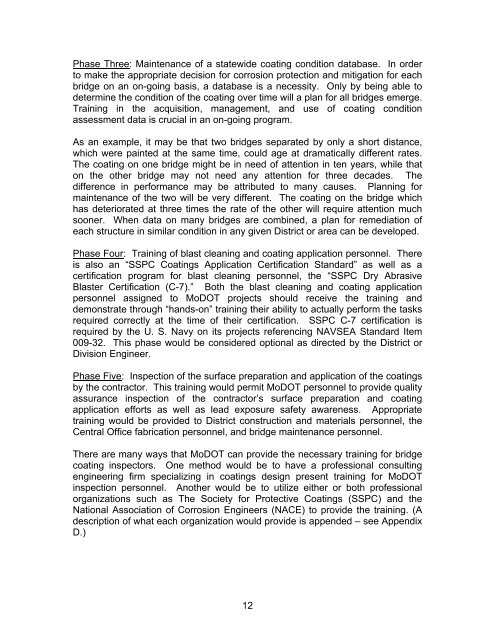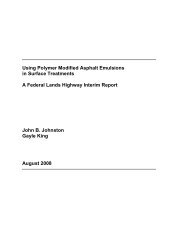An Evaluation of MoDOT's Current Coatings Programs Final ... - TSP2
An Evaluation of MoDOT's Current Coatings Programs Final ... - TSP2
An Evaluation of MoDOT's Current Coatings Programs Final ... - TSP2
You also want an ePaper? Increase the reach of your titles
YUMPU automatically turns print PDFs into web optimized ePapers that Google loves.
Phase Three: Maintenance <strong>of</strong> a statewide coating condition database. In order<br />
to make the appropriate decision for corrosion protection and mitigation for each<br />
bridge on an on-going basis, a database is a necessity. Only by being able to<br />
determine the condition <strong>of</strong> the coating over time will a plan for all bridges emerge.<br />
Training in the acquisition, management, and use <strong>of</strong> coating condition<br />
assessment data is crucial in an on-going program.<br />
As an example, it may be that two bridges separated by only a short distance,<br />
which were painted at the same time, could age at dramatically different rates.<br />
The coating on one bridge might be in need <strong>of</strong> attention in ten years, while that<br />
on the other bridge may not need any attention for three decades. The<br />
difference in performance may be attributed to many causes. Planning for<br />
maintenance <strong>of</strong> the two will be very different. The coating on the bridge which<br />
has deteriorated at three times the rate <strong>of</strong> the other will require attention much<br />
sooner. When data on many bridges are combined, a plan for remediation <strong>of</strong><br />
each structure in similar condition in any given District or area can be developed.<br />
Phase Four: Training <strong>of</strong> blast cleaning and coating application personnel. There<br />
is also an “SSPC <strong>Coatings</strong> Application Certification Standard” as well as a<br />
certification program for blast cleaning personnel, the “SSPC Dry Abrasive<br />
Blaster Certification (C-7).” Both the blast cleaning and coating application<br />
personnel assigned to MoDOT projects should receive the training and<br />
demonstrate through “hands-on” training their ability to actually perform the tasks<br />
required correctly at the time <strong>of</strong> their certification. SSPC C-7 certification is<br />
required by the U. S. Navy on its projects referencing NAVSEA Standard Item<br />
009-32. This phase would be considered optional as directed by the District or<br />
Division Engineer.<br />
Phase Five: Inspection <strong>of</strong> the surface preparation and application <strong>of</strong> the coatings<br />
by the contractor. This training would permit MoDOT personnel to provide quality<br />
assurance inspection <strong>of</strong> the contractor’s surface preparation and coating<br />
application efforts as well as lead exposure safety awareness. Appropriate<br />
training would be provided to District construction and materials personnel, the<br />
Central Office fabrication personnel, and bridge maintenance personnel.<br />
There are many ways that MoDOT can provide the necessary training for bridge<br />
coating inspectors. One method would be to have a pr<strong>of</strong>essional consulting<br />
engineering firm specializing in coatings design present training for MoDOT<br />
inspection personnel. <strong>An</strong>other would be to utilize either or both pr<strong>of</strong>essional<br />
organizations such as The Society for Protective <strong>Coatings</strong> (SSPC) and the<br />
National Association <strong>of</strong> Corrosion Engineers (NACE) to provide the training. (A<br />
description <strong>of</strong> what each organization would provide is appended – see Appendix<br />
D.)<br />
12
















